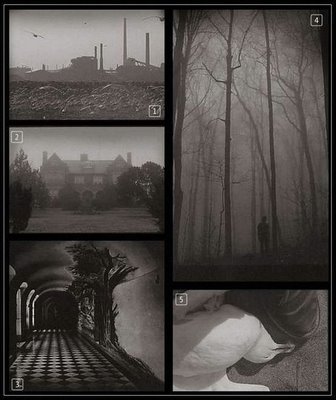
Although Sternime is best known for his films, he is regarded by many to be a photographer first. His cinematic shots were painstakingly researched and planned. Sternime insisted that each of his scenes could be frozen and be taken for photographs in their own right. While planning his shots for a film he would spend months taking photos and developing his visual ideas so that they could stand alone and be appreciated. These recently discovered stills taken by Sternime in the eighties reveal a darker tonality of subject matter. They were undoubtably taken with some cinematic idea in mind. Sadly, these were never developed into any film he made. So they stand soley as a photographic representation of a cinematic project that never occurred. Struggling through his depression and solitude he continued quietly to work through his personal troubles by externalizing what he called his "overbearing dark nothingness within the geography of my mind".
This series of photographs is titled Grey Matter (1988). They were titled and sub-titled by Sternime but were not numbered as they appear here. They were meant to coexist in a group but not within any order. As the name would suggest, they are meant to somehow externalize the psychic dread into the physical world. He invites the viewer to enter his mental blackened psychological realm. Sternime often struggles with the intertwining connections between the physcial and the psychical in his works. Fully aware of his embodied physical existence, Sternime commented "at this one level I know I am comprised of physical elements that determine 'how' I am. Yet I am also certain that 'how I am’ psychically determine my physical existence." Grey Matter is an apt title, referring to the physicality of the "stuff" or "matter" of the brain while also referring to the more abstract "greyness" of his emotional being, "the matter of greyness in my life"
Photo 4 (Amongst Tendrils). A powerful evocation of forlornness, it presents a young man visually overpowered by the complexity of a forest of "tendrils". He is lost within and overwhelmed by the barren dusky greyness of the steep forest of the visually interconnected branches.
Photo 1 (Innocent Beauty) reflects his early childhood memories growing up in an industrial town. Sternime had never been able to shake the effect of the industrial landscape on his imagination "beautiful and horrid in the same billowing plume". Industrial architecture conveyed to Sternime "a solidity of purpose, an economy of design that purely follows function without any need for artifice" The magnificent smokestacks seem to spew toxic smoke to some but soft puffy clouds to the mesmerized child. The innocent seagulls fly about in the foreground of the factory. The moniker of innocent beauty is perhaps more attributed to the factory than the birds. The factory is built with no regard for beauty yet to Sternime it is unconciously or innocently beautiful. The forlornness shown in # 4 is counterposed to the iconic representation of homecoming.
In photo 2 (Dwelling) an estate is enshrouded in a misty haze. It is an ideal home setting of a beautifully landscaped property. Despite such perfection, it is abundantly clear that little life is revealed in the shot. The imagery is more funereal than domestic. One’s lifelong homesickness can only be satisfied with the ultimate blackness of death. So it is here we see Sternime working out what was to become one of his cinematic motifs: that a constant estrangement with the everyday cannot ultimately result in any satisfaction.
In photo 5 (Grounded), a seagull is shown at the foot of the photographer. After a life of flight - a life of ethereal imagination - we are reminded that we will be grounded by the physicality of the everyday world. "After dancing with the stars, we fall back to the ground which is our dwelling".
Photo 3 (Corridors) once again returns to the internal tendrils of the imaginative experience. Black and white photography became much favoured by Sternime during the eighties. "Two colors in opposition, yet together they produce infinite shading." This perfectly symbolized the central opposition in human imagination for Sternime. Human experience is at once capable of the highest highs and the lowest lows. The checkerboard pattern of the floor as well as the alternating pillars revealing light and casting shadow are clues to Sternime’s revelation of this infinite opposition. Yet in the corridor of black and white there grows an organic branching of tendrils again defying the sterility and thriving in spite of the shade.
No comments:
Post a Comment